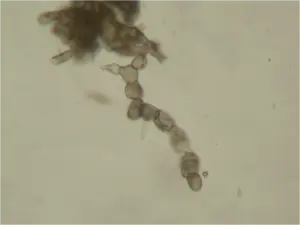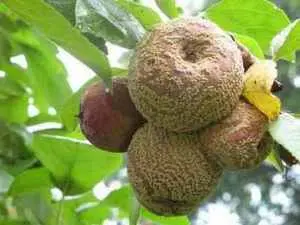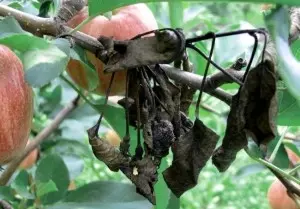Many people, whether they are gardeners or country lovers, have seen rot on apple trees or its fruits more than once. This disease is called apple fruit rot, which is considered the most common disease of this fruit tree. Another name for this disease is apple moniliosis. In terms of its harmfulness, it surpasses even the scab.
What is it like?
Fruit rot or moniliosis is a fungal disease that can infect a wide range of plants. The causative agent of this disease is the ascomycete fungus Monilinia cinerea Honey, which belongs to marsupials. Fighting it is an important part of caring for apple trees.
This disease is characterized by two stages:
- conidial stage. It is caused by the fungus Monilia cinerea Bon. In this case, sporulation occurs in all affected areas of the tree, which looks like small and gray pads. These pads are composed of single-celled chains of colorless conidia. In the spring, conidia infect flowers and, spreading along the shoot, provoke the development of a monilial burn. During the growing season, the fungus produces several generations of conidia, leading to a massive infection of the entire tree;
- sclerotial stage. This is the so-called resting stage.

In some scientific articles, two forms of this disease are distinguished:
- fruit rot – the primary lesions are localized on the fruits, which leads to their rapid deterioration and unsuitability for human consumption. Develops throughout the entire period of fruiting;
- monilial burn or leaf burn – the disease affects flowers, ovaries, branches and leaves, leading to their drilling and drying. Being on a tree for a long time, they take on a burnt appearance.
The greatest danger to the apple tree is the infection of the bark of the branches, which leads to the development of cracks and wounds on it, from which there is an abundant release of gum. This gray rot can cause large areas of wood to dry out, as well as overgrown branches. In the most severe cases of the disease, lesions affect the entire tree. The fungus overwinters mainly in the form of mycelium on fruits (fallen or remaining hanging on branches) and branches. For certain areas (Moldova, the Caucasus, Crimea), it can also winter in the form of conidia. With the onset of spring, the formation of conidial pads on infected areas occurs, which leads to a spring exacerbation of the disease. The fungus carries out a full cycle of its development in a fruitful period.
Causes
There are many factors that contribute to the infection of a tree. However, the main reason that leads to the development of fruit rot is the infection of the apple tree with actinomycetes.
The main reasons include:
- various lesions in the cortex (especially cracks);
- contact of mummified infected fruits with healthy parts of the apple tree;
- damage to the skin of apples due to insect bites (mainly goose and codling moth);
- the presence of other diseases that affect apple trees;
- the presence of phytopathologies;
- contact of various parts of the tree with already infected fruits (especially already mummified ones) or branches;
- high susceptibility of a certain apple variety to this disease. But often even varieties that are resistant to this disease are powerless in confronting it;
- not destroying infected apples and twigs that may accumulate under the tree, thereby contributing to further infection.
Factors that create suitable conditions for infection:
- flowering period;
- past hail;
- infection is possible through the petiole fossa, but subject to the presence of drop-liquid moisture in it;
- air temperature is about +15 degrees;
- high air humidity (70% and above);
- dirty containers that were used to pick apples;
- dirty tools used for pruning or grafting;
- non-disinfected rooms that were used to store garden tools;
- windy weather (this is how the spores of the fungus spread);
- heavy precipitation (fog, snow, rain);
- winter with abundant snow cover;
- cold long spring.
Symptoms
Fruit rot has an incubation period. It takes about five days from the moment of infection to the appearance of the first symptoms, and sporulation begins after 10 days. Actually after that the tree starts to hurt.
Symptoms of fruit rot:
- first, the formation of the first wormy carrion occurs (earlier in summer varieties, later in winter varieties);
- the pulp of the fruit becomes soft and brown;
- the apple begins to rot with a small brown spot;
- this spot gradually increases in size;
- it covers most of the fetus;
- on the surface of a rotting apple, pads form in large numbers;
- the pads are gray and may turn white against the background of apple brown;
- they are located in the form of concentric circles and are the site of the formation of conidia;
- the fruit becomes black or brown;
- further infection of nearby apples occurs;
- as they ripen, the number of affected fruits also increases;
- if the fruit remains hanging on the tree, then the fungus along the stalk from it gets to the fruit branch, the fruit;
- this causes infection of nearby branches in which the fungus will overwinter;
- in the spring, the infection further spreads to the young ovary;
- wilting, followed by the death of overgrown branches.

Symptoms of a monilial burn:
- flowers turn brown or black;
- over time, they dry out;
- then the disease spreads to the ovaries, twigs and fruit twigs;
- on them the leaves begin to turn brown and shrivel;
- the affected leaves do not fall off and gradually acquire a charred black appearance.

How to deal?
This disease is very harmful to the tree, so rot requires consistent treatment.
The main ways to combat moniliosis and its prevention include:
- pruning branches that have dried ends, black leaves and mummified apples;
- burning cut branches and mummified fruits;
- timely harvesting of apples;
- protection of fruits from various mechanical damages during their removal and transportation;
- storage of apples at a temperature of about 0 ° C;
- mandatory disinfection of storage and containers;
- treatment of the apple tree during the growing season with various drugs (for example, fungicides);
- spraying should be carried out periodically;
- carry out timely treatment of other diseases;
- to treat infectious diseases;
- protection of trees from mechanical damage;
- insect control (especially goose, codling moth, sawfly).
The above procedures should be carried out throughout the entire fruitful period, as well as before and after it.
Video “Prevention of fruit rot of apple trees”
In addition, measures to combat fruit rot can be found in the video below.
Knowing the main causes of the development of fruit rot, the first symptomatic manifestations, as well as measures to combat it, you can effectively resist this dangerous disease.
Author: Elena Martynyuk
Loading…









